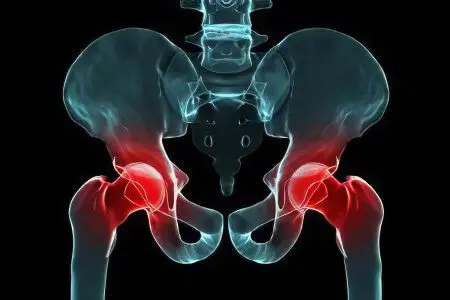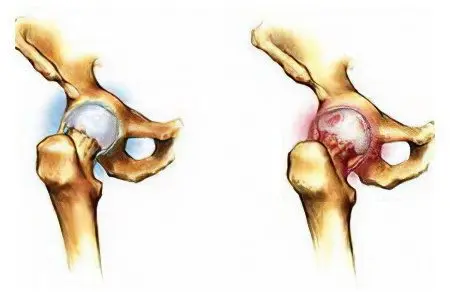Contents
What is hip arthritis
Arthritis of the hip joint is a pathological process characterized by inflammation in the corresponding area. A synonym for the name of this disease is the word “coxitis”.
Most often, elderly people who have crossed the line of 65 years suffer from such a pathology. But in recent decades, there has been a tendency to rejuvenate the disease, and such a diagnosis is made not only for people of working age, but even for small children. If we consider the general statistics, then up to 1% of the population suffers from arthritis of the hip joint, which is a considerable figure.
Rheumatologists, orthopedists and traumatologists classify arthritis of the hip joint according to the etiology and mechanism of the development of the disease:
Rheumatoid arthritis;
reactive arthritis. It affects the hip joint very rarely, while the urogenital or postenterocolic type of the disease is usually diagnosed;
Psoriatic (developing on the background of psoriasis) arthritis;
Infectious arthritis of the hip. This type of disease, in turn, is divided into parasitic, post-traumatic, fungal, infectious-allergic and viral;
Depending on the duration of the disease, arthritis of the hip joint can be acute (the initial manifestation of the disease, lasting no more than 8 weeks), protracted (less than a year), chronic (more than a year) and recurrent, that is, recurring again;
Depending on which tissues arthritis primarily affects (bone or synovial membrane), hip arthritis can be primary synovial (rheumatoid and reactive) or primary bone (infectious arthritis, such as tuberculosis).
Symptoms of hip arthritis

Symptoms of the disease may vary slightly depending on the cause that caused it.
However, there are some signs that are characteristic of all types of arthritis of the hip joint:
Pain in the groin. It may radiate to the buttocks or to the outer thigh. It intensifies during rest and at the initial stages of the development of the disease practically does not bother a person during the day when he is busy with any work;
Suddenly appeared lameness, which develops against the background of muscle atrophy. This causes difficulty in walking. There is such a thing that is characteristic of arthritis of the hip joint as the Trendelenburg gait. During the movements, it is characterized by the pelvis lowered towards the healthy leg. This is due to the weakness of the gluteal muscles;
Sharp pain, which increases significantly during energetic movements of the limb;
Limiting the range of movements performed. The person has difficulty turning the leg to the side;
Rapid fatigue and chronic fatigue even without increased physical activity.
Particularly noteworthy are such forms of hip arthritis as:
Purulentbecause it has a sharp and stormy onset. This is manifested in the symptoms of severe intoxication of the body: fever, sweating, weakness, headache and loss of appetite. Local signs of inflammation are pronounced: the skin in the area of the hip joint becomes tense, red and hot. The nature of the pain is sharp, sometimes pulsating, with shootings in the groin and buttocks. The more the person moves, the more the pain becomes. A purulent effusion is formed in the joint cavity, which significantly changes its shape;
Tuberculous arthritis will be preceded by symptoms of tuberculosis intoxication of the body. Often, a dislocation of the hip is formed against its background, which leads to partial or complete limitation of joint mobility;
For psoriatic arthritis the skin around the joint turns purplish blue, and often there are pains in the spine;
If arthritis of rheumatoid origin, then the hip joints of both limbs will be affected.
Causes of hip arthritis

The causes that provoke the development of arthritis of various forms can be as follows:
Purulent arthritis occurs against the background of previously obtained grass, after taking a puncture or performing an operation, in a word, as a result of any impact with which an infection could be introduced into the joint cavity. Septic arthritis is formed when a purulent focus located in nearby tissues erupts (for example, with osteomelitis or phlegmon), or with metastatic infection. Specific arthritis occurs against the background of tuberculosis, gonorrhea, syphilis, brucellosis;
Some systemic, hereditary and autoimmune diseases, such as psoriasis, Crohn’s disease, lupus erythematosus, etc., can become the cause of the development of arthritis of the hip joint;
The cause of reactive arthritis can be a past intestinal disease, for example, salmonellosis, yersiniosis, dysentery, as well as a urological infection – mycoplasmosis, chlamydia, and others;
Rheumatoid arthritis occurs as a result of gene mutations or autoimmune reactions. At the same time, the human immunity mistakenly begins to destroy its own healthy cells, including those responsible for the integrity of the joint. The impetus can be the herpes virus, measles, mumps, Epstein-Barr, hepatitis, etc.;
Hip dysplasia sometimes causes hip arthritis;
Heredity is an important factor in the likelihood of developing a disease. Therefore, those people whose relatives had a history of problems with the hip joints should be extremely attentive to their own health;
Obesity is one of the most common causes of coxitis. After all, the hip joint accounts for the main load from the weight of the human body. If the weight exceeds the maximum allowable, then the pelvis begins to gradually collapse, and at some point inflammation occurs – arthritis;
Traumatic hip dislocation cannot be ruled out. Over the years, even a successfully healed injury can remind of itself with arthritis;
Excessive physical exertion on the legs associated with professional activities.
Treatment of hip arthritis

For the treatment of the disease, an integrated approach is needed, which may include surgical and orthopedic techniques, as well as taking medications and spa holidays.
The therapy is based on the following principles:
Identification and elimination of the cause that caused arthritis: allergies, infections, gout;
Pathogenetic therapy, which means not only the elimination of the cause of the disease, but also the prevention of its further development. The tasks of pathogenetic therapy are reduced to normalization of metabolism and correction of the immune status. It is also necessary to eliminate inflammation, both general and local. For this, medications and courses of physiotherapy are used;
Rehabilitation is the most important principle of competent treatment of arthritis of the hip joint. To restore its normal functioning, procedures such as massage, acupuncture, reflexology, exercise therapy, etc., will be required;
Elimination of the underlying disease if the arthritis was caused by any infection, such as tuberculosis or enterocolitis. Even if it is not possible to completely remove the pathogen from the body, it is necessary to transfer the pathology to the category of chronic and not in the acute stage.
Medication
Naturally, without taking medication, getting rid of the disease will not work. But in no case should you prescribe them yourself and start taking them without consulting a doctor.
NSAIDs. No treatment for arthritis, including the hip joint, is complete without taking NSAIDs (non-steroidal drugs designed to eliminate inflammation). These funds not only help relieve pain, but also reduce swelling, reduce vascular permeability. A person feels the effect after the first dose.
These include drugs such as ibuprofen, diclofenac, ketorolac, ketoprofen and others. However, they have negative sides – their action is short-lived, and the list of side effects is very impressive. The most dangerous of which are: a decrease in the number of leukocytes and erythrocytes in the blood, an increase in the activity of liver enzymes, the appearance of symptoms of hepatitis, impaired renal function, increased blood pressure, the development of stomach ulcers and gastric bleeding.
Local anesthetics. Often, in order to reduce the risk of side effects, doctors prescribe pain medications that must be applied externally. In this case, we are talking about such products as Dolgit-gel, Bengay, Voltaren-Emulgel, Fastum, Apizartron and other creams, gels and balms. Their undoubted advantage over drugs that need to be taken orally is that they act locally on the joint and do not enter the gastrointestinal tract. However, there is also a minus in such treatment – the hip joint is far from the surface of the skin, which means that local exposure will have a mild effect;
Muscle relaxants. They are designed to relax the muscles, as involuntary muscle contractions are always a problem with hip arthritis. This protective mechanism of the body causes great difficulties for a person when trying to make a movement with a limb.
In addition to limiting mobility, muscles that are in tension for a long time begin to hurt. Medications such as mydocalm, baclofen and sirdalud are able to cope with muscle tension, relieve pain and restore limb mobility. Naturally, like other drugs, they have side effects, the most common of which are: sleep disturbances, dizziness, gastrointestinal disorders, nausea, lowering blood pressure. However, these negative effects, when taken in small doses, quickly disappear or may not occur at all. While muscle pain cannot be tolerated in any case (muscles do not receive enough oxygen, which means they do not remove metabolic products – as a result, pain occurs, which in turn increases spasm).
Minerals. Preparations that mineralize bone tissue are mandatory. These include Vitrum Calcium, Teravit, Biovital, Calcimin. They must be taken by those people who experience nutritional problems and are not able to get all the necessary substances from food. Meanwhile, there are practically no serious contraindications to the use of such additives, except for individual intolerance to the components that make up their composition.
Antibiotics. If the arthritis of the hip joint was caused by any infectious disease, then the source must first be eliminated. For this, antibiotics or antiviral agents are prescribed, while in parallel the patient must take painkillers and anti-inflammatory drugs.
The patient who has received an appointment with a physiotherapist will be individually selected the procedures necessary for the best recovery. They will help you quickly return to a normal lifestyle, increase the range of motion, and also rehabilitate after prolonged inflammation.
Operative intervention

Surgical intervention is indicated when treatment with tablets, ointments, gels and physiotherapy did not give the expected effect.
There are several ways to repair a damaged joint:
Arthroscopic synovectomy. The essence of the intervention is to remove the inflamed fragment of the synovial membrane;
Cartilage transplantation is a relatively new treatment for arthritis. For transplantation, tissue is taken from healthy cartilage, then it is grown in the laboratory and planted in a joint damaged by arthritis;
Endoprosthetics of the hip joint. A major operation aimed at the complete replacement of a diseased joint with an artificial implant.
The introduction of a metal plate that mimics the surface of the joint.
But sometimes invasive methods of treatment are enough, when the articular cavity is simply washed with disinfectant and anti-inflammatory solutions.
Treatment of arthritis of the hip joint is a complex process that cannot be carried out without qualified medical assistance. Effective therapy requires taking medications that have serious side effects, so you should not prescribe them yourself. This will only aggravate the course of the disease and the severity of the symptoms.









